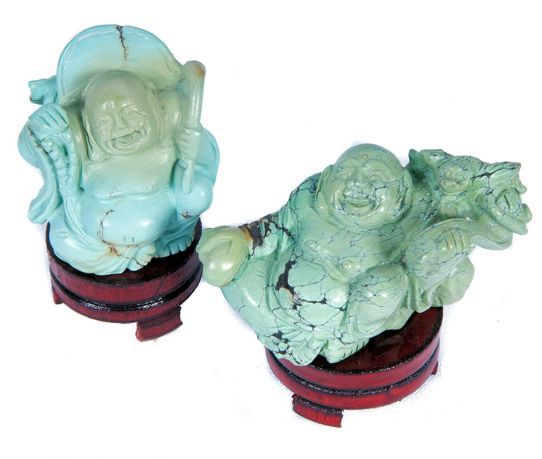We use cookies to make your experience better.
Turquoise netsukes dating from the early 19th century
A netsuke (根 付 pronounced nets'ke, the last e pronounced e que in Spanish) is a hand carved belt knot. This 'button' can be made of various materials. It's just what the maker had often available. Because a traditional kimono had no pockets needed a solution be found to still be able to carry personal belongings. The women were able to stop their few attributes in their sleeves. In the men that gave problems. They had too much and too big items that they had to carry. That's why all strings (Himo) was hung so that dangled beside the body. The cords were scored through the belt (obi) and fastened to the top on a netsuke was again hung over the obi and made sure that the cords are not slipped through behind the obi. The men wore many attributes with it. That could be a holder chopsticks (hashi-ire), or a flint stroke (Hiuchi bukuro) to make the move fire. There was still the inro a box consisting of several appropriate boxes together to transport medicines, herbs, tea or a wax stamp. Often these were cut into attractive shapes and figures. The inro was held together by a slide bead (ojime) that could be pushed up to open the boxes and down to close them again. Often the carrier had a writing (yatate) with. It was at that time customary for wealthy route poems wrote about what they saw. Finally, there was a tobacco pouch (tabakoire) and a pipe holder (kiserutsu) are attached. Already had the real wealthy as a separate vehicle for which groomed and lit the pipe for his master and guests. The netsuke, inro and ojime had always adjusted perfectly. They formed a kind of trinity. The material had to fit together. A metal netsuke would never be hung in a lacquer inro. He would indeed damage the paintwork. The ojime was often made of red coral because with thought this would split to pieces if it would come close to poison. Sometimes thus had a beautifully crafted inro with a hideous ojime. The presentation of the netsuke had a deeper meaning. Usually the wearer wore one of its year of birth, e.g. the 'year of the monkey. " But it could also be a netsuke of the current year, of a saint, patron or a deeper meaning as erotic netsukes. The material could be anything. For example, use a woodcutter usually wood, a fisherman will make a fishbone, but it could also be very small netsuke made of plum or cherry pits. However, there were netsukesi (netsuke carvers) only use the finest and most expensive material. That was usually an expensive ivory or wood. Rare are the netsukes made of gemstone. A netsuke must meet requirements to be allowed to be netsuke. They should fit well in hand without sharp ends. They had to fit in a closed palm. Furthermore, should the string holes (Himo Toshi) worry whereby the cords (Himo) were met. hung at the end than e.g. the inro. If the netsuke was confirmed under the belt and the attributes were hung out, the netsuke was stuck in this position and can not be skewed. The beautiful front had been, after all, for everyone to see. The back was also pretty cut and finished. In this modern age are netsukes hardly worn. Very occasionally at very formal occasions and sometimes wear sumo wrestlers them yet. But the netsuke has increasingly become a collector's item which is mainly gathered angrily in Europe.












